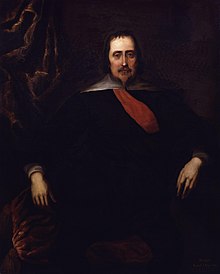
Back Ralph Hopton, 1. Baron Hopton German Ralph Hopton French Ralph Hopton, I barone Hopton Italian ラルフ・ホプトン (初代ホプトン男爵) Japanese Ralph Hopton Polish แรล์ฟ ฮอปตัน บารอนฮอปตันที่ 1 Thai
The Lord Hopton | |
|---|---|
 Sir Ralph Hopton, Baron Stratton | |
| Member of Parliament for Wells 1628 | |
| In office 1640–1642 | |
| Member of Parliament for Somerset | |
| In office 1640–1640 | |
| Member of Parliament for Bath | |
| In office 1625–1626 | |
| Member of Parliament for Shaftesbury | |
| In office 1623–1625 | |
| Personal details | |
| Born | 1596 Witham Friary, Somerset, England |
| Died | 28 September 1652 (aged 56) Bruges |
| Cause of death | Ague |
| Resting place | St Mary, Witham Friary |
| Spouse | Elizabeth Capel (1596-1646) |
| Relations | Sir Arthur Hopton (1588-1650) |
| Parent(s) | Robert Hopton and Jane Kemys |
| Alma mater | Lincoln College, Oxford |
| Occupation | Politician, soldier and landowner |
| Awards | Order of the Bath |
| Military service | |
| Allegiance | |
| Years of service | 1620 to 1625, 1639 to 1646 |
| Rank | Major General |
| Commands | Commander, Royalist Western Army 1643-1646 |
| Battles/wars | Bohemian Revolt 1620-1621 Palatinate 1622-1623 Siege of Breda Wars of the Three Kingdoms Braddock Down; Stratton; Lansdowne; Roundway Down; Cheriton; Torrington |
Ralph Hopton, 1st Baron Hopton KB, JP, DL, MP (1596 – 28 September 1652) was an English politician, military officer and peer. During the First English Civil War, he served as Royalist commander in the West Country, and was made Baron Hopton of Stratton in 1643.
Along with his close friend Sir Edward Hyde (later the Earl of Clarendon), he was made advisor to the future Charles II, when he was appointed to rule the West in early 1644. He commanded the last significant Royalist field army, and followed Charles into exile after surrendering in March 1646. A devout supporter of the Church of England, his personal opposition to Catholicism and Presbyterianism meant he took no further part in the 1638 to 1651 Wars of the Three Kingdoms. He died in Bruges in 1652.
In his stated account of the war, Clarendon described him as 'a man of great honour, integrity, and piety, of great courage and industry, and an excellent officer for any command but the supreme, to which he was not equal'.[1]
- ^ Clarendon 1704, p. 312.